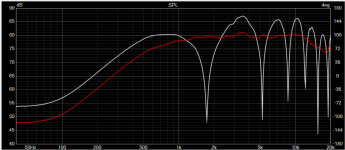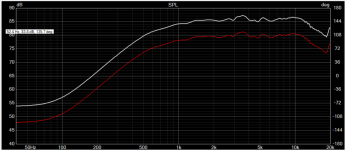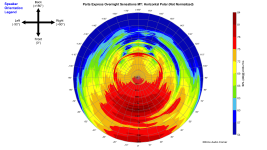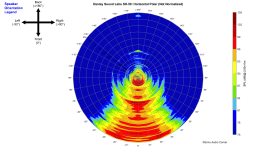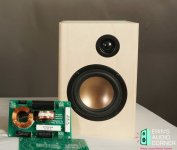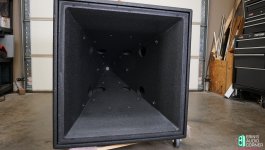Work was slow due to the holidays, and I discovered a really excellent 'tweak' for the stereo in my office.
It's called a tape measure.
I know this sounds a bit silly, but hear me out...
I got my start in audio via car audio. In the car audio world, it is virtually impossible to equalize the pathlengths of the left and right speaker. (Due to sitting off-axis.) Many people use DSP to correct the arrival times.
Everyone should try this if they have a DSP. The effect is startling; you can easily perceive the center of the soundstage moving to the left or to the right.
Nearly every stereo that I've had in my house, I have 'eyeballed' the pathlengths. Basically, I put the speakers down, and sometimes I'll do some rough measurements of where they should be located, but I rarely use a tape measure. The speakers in my house are about 10' (4.7M) away, and I'd long assumed that a pathlength difference of 3-6" wouldn't be the end of the world, because that's a difference of just 3.75%.
In my office, the speakers sit half as far away; a 4.5" pathlength difference would be a difference of 7.5%.
With some time on my hands, I got out the tape measure and measured it EXACTLY, down to the fraction of an inch.
YOWZA!!
Night and day difference. I bought me a semi decent DAC for $150 a couple of years back, and the improvement found by getting the pathlengths EXACTLY right yielded a much greater improvement than what I heard from that DAC.
Here's what I noticed:
1) Every speaker system in my house, up until now, seemed to have highs that were rolled off.
2) None of my stereo setups at the house were able to image beyond the boundaries of where the speakers are located.
3) The center image in all my systems were diffuse. There IS a center image, but it's nebulous.
Getting the pathlengths equalized solved all this.
The importance of this in a car has always been known by me, it's basically "standard operating procedure" with a car stereo, and there aren't many people who are serious about high fidelity car audio who do NOT use DSP delay. But I guess I discounted the importance of it at home, as it's more difficult to get pathlengths EXACTLY perfect in a car. In a car, I rarely move my seat and the speakers are in fixed locations, so DSP delay is a no-brainer.
I have attached two simulations to illustrate what happens when the pathlengths don't match. The sim uses a Dayton RS28A tweeter. In the first sim, there are two RS28As, three meters from the listener. Each side of the triangle is 3.46M long.
The sims illustrate that the stereo response is flat at the listeners seat but only when they're 100% equidistant. When a single speaker is moved just 4.5" (114.3mm) on the Z axis (distance), comb filtering rears it's ugly head.
And I think that is why the treble sounds so much cleaner and clearer when the spacing is exactly right; even a difference of a fraction of an inch makes a difference.
Even more exciting, is that the sound staging and envelopment is just night and day too. For instance, I was listening to something tonight, using this setup, and noticed that the center of the stage had drifted to the left by about 15-30cm. At first I thought that maybe something had gone wrong with my equipment, but then the soundstage 'snapped' back into the center, and I realized that the issue was the recording itself.
IE - the pathlengths were so tightly aligned, I was able to perceive something that I hadn't noticed before in the recording.
It's called a tape measure.
I know this sounds a bit silly, but hear me out...
I got my start in audio via car audio. In the car audio world, it is virtually impossible to equalize the pathlengths of the left and right speaker. (Due to sitting off-axis.) Many people use DSP to correct the arrival times.
Everyone should try this if they have a DSP. The effect is startling; you can easily perceive the center of the soundstage moving to the left or to the right.
Nearly every stereo that I've had in my house, I have 'eyeballed' the pathlengths. Basically, I put the speakers down, and sometimes I'll do some rough measurements of where they should be located, but I rarely use a tape measure. The speakers in my house are about 10' (4.7M) away, and I'd long assumed that a pathlength difference of 3-6" wouldn't be the end of the world, because that's a difference of just 3.75%.
In my office, the speakers sit half as far away; a 4.5" pathlength difference would be a difference of 7.5%.
With some time on my hands, I got out the tape measure and measured it EXACTLY, down to the fraction of an inch.
YOWZA!!
Night and day difference. I bought me a semi decent DAC for $150 a couple of years back, and the improvement found by getting the pathlengths EXACTLY right yielded a much greater improvement than what I heard from that DAC.
Here's what I noticed:
1) Every speaker system in my house, up until now, seemed to have highs that were rolled off.
2) None of my stereo setups at the house were able to image beyond the boundaries of where the speakers are located.
3) The center image in all my systems were diffuse. There IS a center image, but it's nebulous.
Getting the pathlengths equalized solved all this.
The importance of this in a car has always been known by me, it's basically "standard operating procedure" with a car stereo, and there aren't many people who are serious about high fidelity car audio who do NOT use DSP delay. But I guess I discounted the importance of it at home, as it's more difficult to get pathlengths EXACTLY perfect in a car. In a car, I rarely move my seat and the speakers are in fixed locations, so DSP delay is a no-brainer.
I have attached two simulations to illustrate what happens when the pathlengths don't match. The sim uses a Dayton RS28A tweeter. In the first sim, there are two RS28As, three meters from the listener. Each side of the triangle is 3.46M long.
The sims illustrate that the stereo response is flat at the listeners seat but only when they're 100% equidistant. When a single speaker is moved just 4.5" (114.3mm) on the Z axis (distance), comb filtering rears it's ugly head.
And I think that is why the treble sounds so much cleaner and clearer when the spacing is exactly right; even a difference of a fraction of an inch makes a difference.
Even more exciting, is that the sound staging and envelopment is just night and day too. For instance, I was listening to something tonight, using this setup, and noticed that the center of the stage had drifted to the left by about 15-30cm. At first I thought that maybe something had gone wrong with my equipment, but then the soundstage 'snapped' back into the center, and I realized that the issue was the recording itself.
IE - the pathlengths were so tightly aligned, I was able to perceive something that I hadn't noticed before in the recording.
Attachments
I'm sure that 80% of you are reading this thread and asking yourself "did it really take Bateman 35 years to figure out that pathlengths are important?"
Of course, I knew they are; I guess I didn't appreciate that a difference of even 2-3cm makes an audible difference, and that getting the space EXACTLY right is almost like focusing an optical lens.
Of course, I knew they are; I guess I didn't appreciate that a difference of even 2-3cm makes an audible difference, and that getting the space EXACTLY right is almost like focusing an optical lens.
The Danley SH-50 is probably the best imaging speaker I've ever heard, but the frequency response DOES leave something to be desired. I don't think this is a controversial statement. Danley basically used DSP to flatten out the response of a Synergy Horn for his home HiFi gear. Erin's measurements showed that the 'stock' response is not as flat as direct radiators. When I rented a pair of SH50s, I did not set them up with a tape measure, but they image like crazy. I'd long assumed that this was due to the excellent phase response. But I now wonder if part of that is because there is absolutely NOTHING above 350Hz that's hitting the back wall of my room. I've attached a couple of measurements from Erin; the first is from a direct radiator (Parts Express "Overnight Sensations".) The second is from a Danley SH50. Note that the large mouth of the SH50 horn prevents any radiation to the back. The direct radiator does not do this, and I assume that a direct radiator will have quite a bit of energy hitting the back wall and then reflecting back into the radiation of the loudspeaker, leading to comb filtering, which then causes a series of peaks and dips in the response.
Attachments
Hi,
yeah positioning is single most powerful thing one can do with their system!
Phantom center on a stereo system forms when two sound sources perform as one. First early specular reflections make six additional sound sources in a cubicle room, per speaker, which all are really almost as loud (for a wide coverage system) as direct sound and together really dominate over the direct sound, especially on small rooms where they arrive only few milliseconds behind direct sound. Brain ain't fooled easily, but if you equalize distances to boundaries, remember adjust toe-in as well, to make left and right more similar to each other enhancing the phantom image.
I like to listen "quality of phantom center image" with pink noise, when it's hazy big blob between speakers the image is quite bad, but when it tightens down to a concise spot between the speakers, and the speakers itself sound mute as if all sound was concentrated in the middle, the imaging is really great. Matching left and right by positioning including the listener position is most important thing one can do. At least on my place with my system it's clearly audible how listening distance affects, listened from back of the room the (phantom center) sound is big hazy blob, but walking closer at particular distance the sound collapses to concise point as described above. Localization and clarity makes huge leap when brain picks out the direct sound from all the noise in the room and is finally fooled for the phantom center.
yeah positioning is single most powerful thing one can do with their system!
Phantom center on a stereo system forms when two sound sources perform as one. First early specular reflections make six additional sound sources in a cubicle room, per speaker, which all are really almost as loud (for a wide coverage system) as direct sound and together really dominate over the direct sound, especially on small rooms where they arrive only few milliseconds behind direct sound. Brain ain't fooled easily, but if you equalize distances to boundaries, remember adjust toe-in as well, to make left and right more similar to each other enhancing the phantom image.
I like to listen "quality of phantom center image" with pink noise, when it's hazy big blob between speakers the image is quite bad, but when it tightens down to a concise spot between the speakers, and the speakers itself sound mute as if all sound was concentrated in the middle, the imaging is really great. Matching left and right by positioning including the listener position is most important thing one can do. At least on my place with my system it's clearly audible how listening distance affects, listened from back of the room the (phantom center) sound is big hazy blob, but walking closer at particular distance the sound collapses to concise point as described above. Localization and clarity makes huge leap when brain picks out the direct sound from all the noise in the room and is finally fooled for the phantom center.
If I may... are your L and R speakers toed-in and pointing precisely at your ears, 0° off-axis? Even 0.5° off-axis on either L or R, by just 1" at a 10' listening distance, can reduce significantly the very highest audible frequency, because it is totally directional. Any turning of the head has an even bigger effect, from both positional offset and angular asymmetry. Hearing is most acute frontL/R not straight in front or to one side. (Interesting to note, turning one's head to face a perceived sound, whether real sound or imaged by stereo speakers, the closer ear actually heard less high than before, but in balance with the other ear.) The sweet spot is extremely "shallow" in that moving forward or back even 1" will miss the on-axis-only very highest audible frequency.
Fidelity is fundamentally limited by bandwidth.
So, have you controlled for axial asymmetry, and then tested with a tape measure moving one speaker closer/farther? This is a serious psychoacoustic question; I wouldn't guess that the L/R two halves of our ear/brain collaboratively performed timing interferometry down below 1/10000sec.
And I do get holographic soundstage without using a tape measure... by making sure I heard the very highest frequency I still could hear. Lastly, I theorized that image depth is a monophonic effect dependent on time- and phase-coherence (as is perfect transcient response); please see my thread "audio-lensing and holographic depth perception":
Fidelity is fundamentally limited by bandwidth.
So, have you controlled for axial asymmetry, and then tested with a tape measure moving one speaker closer/farther? This is a serious psychoacoustic question; I wouldn't guess that the L/R two halves of our ear/brain collaboratively performed timing interferometry down below 1/10000sec.
And I do get holographic soundstage without using a tape measure... by making sure I heard the very highest frequency I still could hear. Lastly, I theorized that image depth is a monophonic effect dependent on time- and phase-coherence (as is perfect transcient response); please see my thread "audio-lensing and holographic depth perception":
Ha! (mods don't lounge this yet)
After dozens of diy experiments under a wide range of (domestic) conditions and speaker/listener placements (including height), I'm reasonably convinced by the empirical evidence and common-sense inference to state a theory of soundstage imaging depth. Bits had been posted over time to the Full Range Photo Gallery and various threads such as on-going "ragged coaxials".
Metaphysics or psycho-acoustics -- a progression?
Claim 1: It is the monophonic recording-through-to-playback-chain that is responsible for enabling soundstage depth perception; the...
After dozens of diy experiments under a wide range of (domestic) conditions and speaker/listener placements (including height), I'm reasonably convinced by the empirical evidence and common-sense inference to state a theory of soundstage imaging depth. Bits had been posted over time to the Full Range Photo Gallery and various threads such as on-going "ragged coaxials".
Metaphysics or psycho-acoustics -- a progression?
Claim 1: It is the monophonic recording-through-to-playback-chain that is responsible for enabling soundstage depth perception; the...
Last edited:
Indeed! I've taken it for granted that it's critical to tiny fractions simply because that's the WL sizes up in the HF BW and also why I've relied heavily on youthful females for fine tuning as a reliable measurement 'system'.I'm sure that 80% of you are reading this thread and asking yourself "did it really take Bateman 35 years to figure out that pathlengths are important?"
Of course, I knew they are; I guess I didn't appreciate that a difference of even 2-3cm makes an audible difference, and that getting the space EXACTLY right is almost like focusing an optical lens.
But I now wonder if part of that is because there is absolutely NOTHING above 350Hz that's hitting the back wall of my room.
An inexpensive laser distance finder rocks as a stereo setup tool....essential kit imo.
I think you are probably correct about the extended-low pattern control solidifying the stereo image.
I find my larger MEHs create a strong "they are here" kind of image.
(It's also nice the MEHs have a fairly wide constant directivity, that keeps the listening angle / toe in, from needing to be so dang precise. )
I invested in a cheap laser tape measure that's been really helpful, but in my space with my speakers getting them dead on with the tape measure doesn't translate to a stable center or good balance between each. It always results in the right side feeling louder than the left. I have to pull the left speaker out about an inch compared to right for things to sound right. Simply adding gain to the left speaker doesn't seem to balance things out the same as moving the speaker forward. It kind of drives me insane because my OCD wants a visually perfect setup.
I've run into some weird stuff trying to match left and right. For most setups pink noise and sweeps tend to sound like they're at different pitches when comparing speakers. I also of course measure each driver close mic'd and they usually match very well. Speakers with good dispersion seem to be a lot easier to dial in, my flat faceplate to 6.5" woofer two ways are damn near impossible to get a nice balanced image out of.
I believe I might just have an issue with my left ear but it's weird. My hearing tests come out at ENT come out perfect, but I don't feel like I hear the left the same anymore. Sometimes I can boost the channel till it sounds balanced, and my brain or ear will just counter act it and after a few seconds I'm right back to feeling like the right side is louder.
I've run into some weird stuff trying to match left and right. For most setups pink noise and sweeps tend to sound like they're at different pitches when comparing speakers. I also of course measure each driver close mic'd and they usually match very well. Speakers with good dispersion seem to be a lot easier to dial in, my flat faceplate to 6.5" woofer two ways are damn near impossible to get a nice balanced image out of.
I believe I might just have an issue with my left ear but it's weird. My hearing tests come out at ENT come out perfect, but I don't feel like I hear the left the same anymore. Sometimes I can boost the channel till it sounds balanced, and my brain or ear will just counter act it and after a few seconds I'm right back to feeling like the right side is louder.
Last edited:
I had a similar experience at my old house; when I initially set up my system I used a tape measure and microphone and everything was correct and wonderful, but after some time the center imagine moved a little bit more left than it should have been. I assumed it was in my head or I had hearing loss in my right ear. Turned out that the distance between the left speaker and listen position had ended up slightly closer than it originally was after a year or two of housecleaning and flopping onto the sofa. Fixed that and everything was right again. But yeah, what 0.3ms of delay can do made an impression on me.I'm sure that 80% of you are reading this thread and asking yourself "did it really take Bateman 35 years to figure out that pathlengths are important?"
Of course, I knew they are; I guess I didn't appreciate that a difference of even 2-3cm makes an audible difference, and that getting the space EXACTLY right is almost like focusing an optical lens.
If it can reassure you, I have the same OCD with the left speaker,sometimes it's exhausting.I invested in a cheap laser tape measure that's been really helpful, but in my space with my speakers getting them dead on with the tape measure doesn't translate to a stable center or good balance between each. It always results in the right side feeling louder than the left. I have to pull the left speaker out about an inch compared to right for things to sound right. Simply adding gain to the left speaker doesn't seem to balance things out the same as moving the speaker forward. It kind of drives me insane because my OCD wants a visually perfect setup.
I've run into some weird stuff trying to match left and right. For most setups pink noise and sweeps tend to sound like they're at different pitches when comparing speakers. I also of course measure each driver close mic'd and they usually match very well. Speakers with good dispersion seem to be a lot easier to dial in, my flat faceplate to 6.5" woofer two ways are damn near impossible to get a nice balanced image out of.
I believe I might just have an issue with my left ear but it's weird. My hearing tests come out at ENT come out perfect, but I don't feel like I hear the left the same anymore. Sometimes I can boost the channel till it sounds balanced, and my brain or ear will just counter act it and after a few seconds I'm right back to feeling like the right side is louder.
Interesting post! However 10' is 3.05 metres. 👍The speakers in my house are about 10' (4.7M) away,
An inexpensive laser distance finder rocks as a stereo setup tool....essential kit imo.
I think you are probably correct about the extended-low pattern control solidifying the stereo image.
I find my larger MEHs create a strong "they are here" kind of image.
(It's also nice the MEHs have a fairly wide constant directivity, that keeps the listening angle / toe in, from needing to be so dang precise. )
I wrote the post at something like 1am last night and didn't have time to touch on the topic you describe, but that was the first thing I wanted to explore:
Does the size of a high frequency source reduce the importance of pathlength?
A couple of anecdotes:
1) When I rented Danley SH50s, I didn't place them with a tape measure. Even weirder, when in MONO the SH50s sound bigger than a regular speakers. I've told the story a hundred times: our daughter was literally sitting less than a meter away from the left speaker in a stereo SH50 setup, and my other speakers were in the room too, and she asked me if the SH50s were playing. If a teenage girl with crazy good hearing (she played in an orchestra) can't tell if a speaker is radiating sound, that's WILD.
2) I once went to a concert that used some absolutely RIDICULOUS L'Acoustic arrays, and it was the first time I've ever perceived a soundstage at a rock concert. There was a noticeable stereo soundstage and the highs were extended and clear. I was also sitting quite a bit out of the 'sweet spot.'
So there seems to be something to this; I am guessing that a large high frequency source may be less sensitive to the location of a listener than a small high frequency source. VituixCad should be able to simulate this, because it can simulate arrays, dome tweeters, waveguides etc. (This assumes you calculate the response of the waveguide and enclosure in a 3rd party app like ATH+ABEC.)
- Home
- Loudspeakers
- Multi-Way
- Excellent Ten Dollar Loudspeaker Tweak
